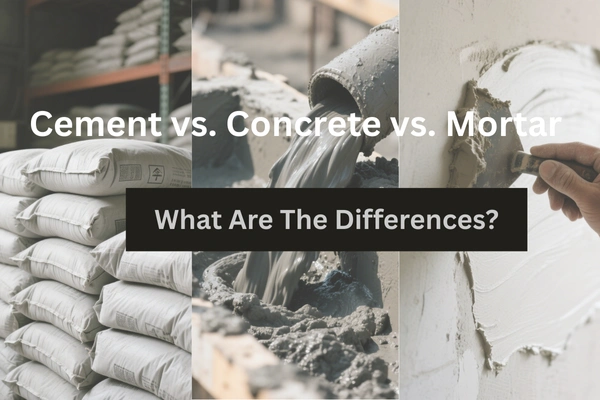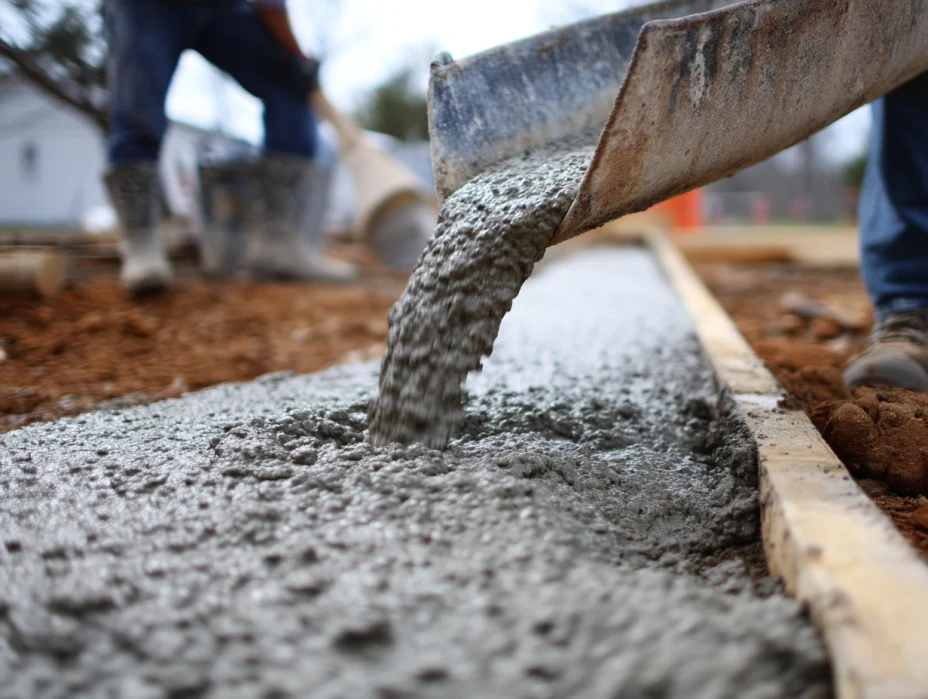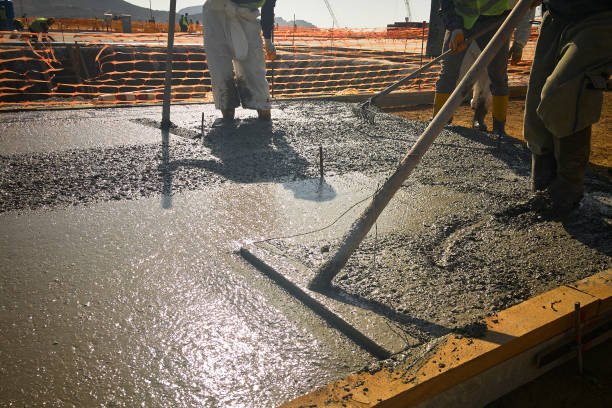
What Is Cement?
Cement is a fine, gray powder that acts as a binder—meaning it helps hold things together. On its own, it doesn’t do much, but when you mix it with water, a chemical reaction occurs that hardens the cement. This process is called hydration.
Think of cement like flour in baking: you wouldn’t eat flour on its own, but it’s essential for making bread or cake. Similarly, cement isn’t typically used by itself—it’s a key ingredient in larger mixtures like concrete.
The most common type of cement is portland cement, used in many areas of construction. It serves as the basic ingredient in concrete, mortar, stucco, and grout. Despite the name, it does not come from Portland, Oregon, but was named by its inventor after the high-quality Portland stone from the Isle of Portland in England, because the finished product resembled it.
What Is Cement Made Of?
Main Raw Materials of Cement:
- Limestone (provides calcium)
- Clay or shale (provides silica, alumina, and iron)
- Gypsum (small amount, added to control setting time)
Cement is a fine gray powder made from limestone, clay, and other materials that are calcined at high temperatures in a kiln to form clinker. The clinker is then ground with an appropriate amount of gypsum to form the fine powder we know as cement.
What Is Cement Used For?
Cement is a crucial building material with numerous uses in construction and infrastructure development. It is primarily used to make concrete and mortar, which are essential for constructing buildings, bridges, roads, dams, and tunnels.
Cement provides strength, durability, and resistance to weathering, making it ideal for foundations, walls, floors, and pavements. It is also used in plastering, flooring, and waterproofing structures.
Additionally, cement is employed in precast products like pipes, blocks, and panels, as well as in soil stabilization for roads and runways. Its versatility, bonding properties, and long-lasting nature make cement indispensable in modern construction and engineering projects.

What Is Concrete?
Concrete is one of the most widely used construction materials in the world. It’s a strong, durable, and versatile material formed by mixing cement, water, and aggregates (sand, gravel, or crushed stone). When these ingredients combine, they harden into a solid mass, making it ideal for building everything from houses to highways.
What Is Concrete Made Of?
Concrete = Cement + Water + Sand + Gravel
- Cement – Acts as the binder (usually Portland cement).
- Water – Triggers the chemical reaction (hydration) that hardens the mix.
- Aggregates – Sand (fine aggregate) and gravel/crushed stone (coarse aggregate) provide strength and bulk.
- Optional Additives – Chemicals or fibers may be added to improve durability, workability, or setting time.
Uses of Concrete
Concrete’s durability and adaptability make it essential for:
- Buildings (foundations, columns, floors, roofs)
- Roads & Bridges (high-strength, long-lasting surfaces)
- Dams & Tunnels (water-resistant and load-bearing)
- Precast Products (pipes, blocks, panels)
- Decorative Applications (stamped, polished, or colored finishes)

What Is Mortar?
Mortar is a construction material made by mixing binders (such as cement, lime, or clay), fine aggregates (mainly sand), and water in specific proportions. It is primarily used in masonry, plastering, and flooring works.
Types of Mortar
- Conventional Mortar: Typically composed of cement and sand, known for its high strength and durability.
- Dry-Mix Mortar: A pre-mixed dry formulation offering improved convenience and consistent quality during application.
- Specialty Mortars: Include waterproof, high-strength, or other function-specific mortars, formulated with additives tailored to meet particular performance requirements.
What Is in Mortar?
Basic Components:
- Binders: Materials like cement and lime that react with water to develop adhesive properties through hydration.
- Fine Aggregates: Mainly sand, which provides body and structural support to the mixture.
- Water: Regulates the mixture’s workability and initiates the setting and hardening process.
Main Applications of Mortar
- Masonry: Used to bond bricks, stones, and other building units.
- Plastering: Fills wall joints and creates smooth, even surfaces.
- Flooring: Serves as a leveling or base layer for floors.
- Repairing cracks & joints
- Tile setting (thin-set mortar)
You can read our previous article about how to apply the tile adhesive.

How Cement, Concrete, and Mortar Are Related
Cement is the most common ingredient in both concrete and mortar.
Cement (binder)
│
├── + Water + Sand + Gravel → Concrete (strong, structural)
│
└── + Water + Fine Sand → Mortar (adhesive, non-structural)
Cement vs. Concrete vs. Mortar: Key Differences Compared
| Feature | Cement | Concrete | Mortar |
|---|---|---|---|
| Type | Binder (ingredient) | Building material | Binding material |
| Composition | Limestone, clay, gypsum | Cement + water + sand + gravel | Cement + fine sand + water |
| Strength | High (when mixed) but brittle on its own | Very strong and durable | Less strong but good for bonding |
| Primary Use | Ingredient for concrete/mortar | Structural projects (buildings, roads) | Holding bricks and stones together |
| Appearance | Fine powder | Thick mix with gravel | Thick, smooth paste (no gravel) |
| Consistency | Powder | Thick, pourable (when wet) | Smooth, workable paste |
| Durability | N/A (used in mixtures) | Extremely durable | Less durable than concrete |
How to Know Which One You Need
If you’re doing a small home project, here’s a quick guide to help you choose:
Use Cement if:
- You are mixing your own mortar or concrete.
- You need a binding ingredient to add to sand and gravel.
⇒ Cement is not used alone—it needs to be mixed with other ingredients.
Use Concrete if:
- You are building something strong, like a patio, driveway, or foundation.
- You need the material to support weight or pressure.
⇒ Concrete is best for structure and support.
Use Mortar if:
- You are laying bricks, stones, or blocks.
- You need something to stick materials together.
⇒ Mortar is ideal for bonding and finishing work.
FAQs
1. Can I use mortar instead of concrete?
No, mortar is not as strong as concrete. If you try to build something structural with mortar, it may crack or fall apart over time.
2. Can I make concrete without cement?
No, cement is what holds everything together. Without cement, the sand and gravel won’t bind, and you won’t get solid concrete.
3. What happens if I use the wrong one?
Using the wrong material can lead to weak or unstable structures. For example, using mortar instead of concrete for a driveway may result in cracks and damage.
4. What is a sidewalk made of?
A sidewalk (or pavement) is typically made of concrete, asphalt, brick, or stone.
Conclusion
Cement, concrete, and mortar are all essential materials in construction, but they each have different roles:
- Cement is the binder and main ingredient.
- Concrete is used for structural work.
- Mortar is used for bonding bricks and stones.
By understanding how they differ and when to use each one, you can make better choices for your projects and ensure strong, lasting results. Whether you're a professional builder or a weekend DIYer, knowing the difference between these materials will make your work more effective and efficient. Additionally, this article on how long it takes concrete to set may also be helpful for your project.


Leave a Reply